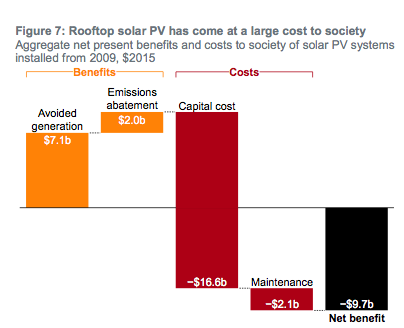Oh dear. Here we go again. The solar industry is clearly winning the battle to turn the global electricity industry upside down and inside out. The plunging cost of battery storage will accelerate that process. It’s just that some people have a hard time accepting it.
This week we have seen another big report into solar, and yet another that gets it terribly wrong.
“Solar homes burnt by the sun”, wrote Fairfax Media, and others followed. Predictably. But Why? Because the Grattan Institute wrote in a report that the economic costs of rooftop solar outweighed the benefits by more than $9 billion.
If Grattan’s goal was to secure big headlines, let’s give it a credit. But to achieve it, it had to concoct a witch’s brew of mistaken assumptions and omissions.
That’s a shame. The conclusions it makes at the end of the report and its recommendations on how to incorporate the inevitable surge in battery storage are important, even if not terribly new.
But they will be obscured by the numbers that have and will be used like confetti by those seeking to restrain the deployment of solar PV in an attempt to protect vested interests.
The numbers it uses are wrong in so many ways it is difficult to know where to start. But because it got the headlines, let’s start with that $9 billion figure.
Grattan Institute argues that the cost of solar PV ($18 billion) overwhelms the benefits ($9 billion mostly in avoided generation costs, and a little in avoided emissions), and it further suggests that individual households are getting little bang for their buck from their individual systems
The first thing it gets wrong is to base its report on the assumption that solar systems only last for 15 years. Most solar systems are likely to last 25, or even 30 years. Some even more. So right at the start, Grattan has underestimated the benefits in avoided grid costs and abatement by at least 40 per cent. That’s a critical number that delivers an entirely different outcome.
And then – like so many other reports – it adds up the costs, but not all the benefits. In this case, it dismisses the lowering of wholesale electricity prices caused by the proliferation of solar PV, which, it argues, “does not constitute a net economic benefit to society”.
Instead, Grattan borrows terminology from the Warburton Review to describe this lowering of wholesale prices as a short-term financial transfer from “existing generators to electricity retailers” who may then pass these savings onto consumers.
Well, it just happens that most of those existing generators and electricity retailers are one and the same entities – hence the name “gentailers” (Origin Energy, AGL Energy, EnergyAustralia). If they are pocketing the profits, it’s the incumbents with their hand in the till, not the solar households, and a regulatory fault.
And there is no doubt that wholesale prices have fallen. The Queensland government’s biggest coal generator, Stanwell Corp, blamed solar PV exclusively on its inability to deliver a profit result in 2013.
Green Energy Markets, in late 2013, estimated the cost reduction from solar PV at $2.70/MWh. Spread over a year that amounts to $540 million in savings (based on the 200TWh consumed in the National Electricity Market). Spread over the 15 years used in Grattan’s calculations, that amounts to $8 billion.
But the University of Melbourne argued that the savings were even greater. It suggested that rooftop solar PV could be responsible for a reduction of $2-$4/MWh in average price per 1,000MW across the NEM. Given that there is now nearly 4,000MW of solar PV installed in the NEM (that doesn’t include WA), then the savings per year could be $2 billion. Over 15 years, that makes a total of $30 billion.
For the full story: http://reneweconomy.com.au/2015/solar-energy-needs-smart-solutions-not-dumb-economics-63384


